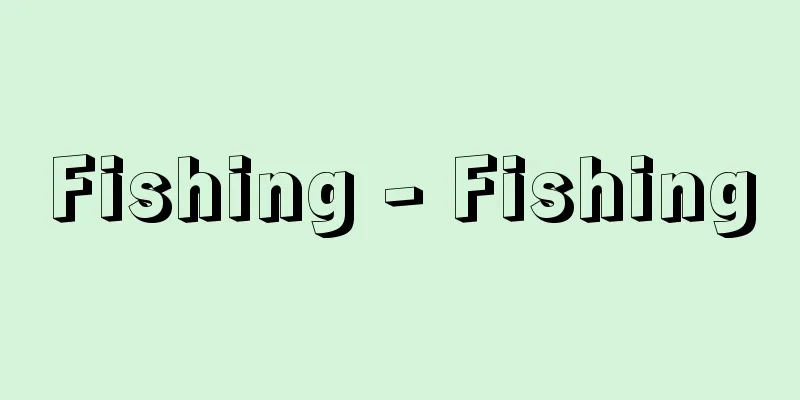Fishing - Fishing

|
Generally speaking, fishing can be broadly divided into professional fishing and hobby or leisure fishing based on the purpose. The former should be called fishing, and should be distinguished from fishing by anglers who enjoy it as a hobby, or game fishing. This article will discuss fishing as a hobby. [Hideto Mori] The significance of fishingFishing has become so popular in recent years that it has become the representative form of human play without even asking the basic question, "What is fishing?" However, for some reason, fishing is not even mentioned in famous works that study human culture and play, such as Huizinga's "Homo Ludens" and Caillois's "Man and Play." The reason for this is probably because fishing was simply considered to be a general term for catching fish. In other words, it seems to have been considered to be the same as other fishing methods such as net casting. Even today in Southeast Asia, there is a fishing method in which fish are killed with a club, and it is true that fishing is considered to be part of that method. In short, the concept of fishing as a source of livelihood was strong. What is the secret behind how fishing has gradually taken on a stronger element of play and expanded to the point where the number of anglers in Japan today is said to be 20 million? Perhaps it must be because fishing has a great appeal other than catching fish. Fishing is a repeated cycle of excitement: tension, ecstasy, and relief. Tension builds up during the preliminary stages of planning, preparing, setting sail, and casting the bait. This is followed by the ecstasy of the series of stages of catching a fish: getting the bite, setting the hook, and catching the fish. Then, the sense of fulfillment and satisfaction that soon comes will liberate the fisherman's mind. Caillois lists dizziness as an important purpose of play, and this can be considered to be the ecstasy he is referring to. It momentarily destroys the stability of perception, causing a kind of comfortable panic. It causes psychological convulsions and paralysis. The reason why men prefer fishing to women is because they secrete more male hormones called androgens and adrenaline (adrenal cortex hormone) than women. Both substances increase the hunting instinct and aggressive instinct. [Hideto Mori] History of FishingAncientFishing began as a way to obtain protein and has developed into a pillar of fishing culture, but its origins go back a long way. The basic techniques for fishing are hooks and lines. The invention of lines and ropes can be traced back to the Paleolithic period, when pottery did not exist. The invention of fishing hooks is said to have occurred between the Paleolithic period and the Neolithic period, when pottery was invented, and anthropologists believe that they were inspired by harpoons, which were used to spear animals. Harpoons were originally just sharp spears, but eventually barbs were added. Barbs have been seen on fishing hooks from the beginning, supporting the harpoon-inspired theory. After the Stone Age, in the Chalcolithic Period, in addition to fishing hooks made from bones and horns, those made from copper appeared, and around this time, a tendency towards recreational fishing as a pastime or hobby can be seen. However, it was not until the Middle Ages that fishing was revived as a recreational activity and part of the culture of leisure in any country. [Hideto Mori] JapanFishing or fishing first appears in Japanese literature as far back as the Kojiki and Manyoshu, where there is a generous account of Emperor Chuai's Empress Okinagatarashihime, later known as Empress Jingu, undoing the strings from her kimono and fishing for sweetfish with a grain of rice. In the Edo period, recreational fishing became popular among all classes, including samurai, townspeople, and craftsmen. Tsugaru Unemenosho, the son-in-law of Kira Kozukenosuke, known from Chushingura, was said to be a fishing fanatic, and wrote an introductory book on fishing called Chogyo Hiden Kasenroku (1723). The book includes a note saying, "This is the original guide for fishermen," and focuses on fishing for flatfish in spring and autumn, with the first volume including fishing spots off the coast of Shinagawa (Tokyo Bay), the second volume including fishing gear and bait, and the third volume including detailed information on judging the weather and tides. In addition, "Fisherman's Guide" was published in 1770 (Meiwa 7), and "Land Fishing Handbook: Light in the Dark" was published in 1788 (Tenmei 8). These books even include the names of fishing tackle merchants, proving how popular recreational fishing was in those days. Many other books on fishing were published in the Edo period, and they were extremely diverse, ranging from novels and introductory books to ghost stories and rakugo. Meanwhile, there is also an anecdote about a feudal lord who encouraged fishing as a way to train his samurai during times of peace. In the Kaga domain (Ishikawa prefecture), he encouraged his retainers to go sweetfish fishing, apparently because the bamboo sweetfish rods were long and heavy and were considered ideal for building up physical strength, and thus the unique Kaga fishing rod was born. In the Shonai domain (Yamagata prefecture), the lord himself is said to have taken the initiative to go black porgy fishing, and the prosperity of this fishing gave birth to the famous Shonai fishing rod. It is said that the samurai referred to going fishing as a "challenge." From the Meiji to the Taisho and Showa periods, fishing as a hobby became more and more popular. In 1906 (Meiji 39), Ishii Kendo's "The Secret Art of Fishing: The Angler's Disposition" was published, with a preface written by Koda Rohan, a writer known for his love of fishing, that accurately captured the essence of fishing. This book is structured as a combination of a travelogue and an account of fishing experiences, but it was highly praised as an introductory book to fishing. The first book that was nearly perfect was Matsuzaki Meiji's "Encyclopedia of Fishing Techniques" (published by Asahi Shimbun) in 1942 (Showa 17), which reported on a nationwide survey of fishing techniques, tackles, bait, etc. In the same year, "A Guide to Kanto's Million Carp Fishing Spots" (published by Morita Haruo, published by Sankosha) was published, and it is interesting to see how large the number of anglers was at the time. [Hideto Mori] worldRecreational fishing made remarkable progress in Europe during the Middle Ages. In England, fishing-loving clergymen such as Archbishop Ambrose appeared, and many books on fish and fishing were published, but what is considered to be the world's first introductory book on fishing was published in 1494 by an English woman named Juliana Berners. However, the book that is considered the bible of fishing and is still in print today is the Comprehensive Angler (1653) by the Englishman Izaak Walton (1593-1683). The book is entitled "A diversion for the contemplative", and shows the eagerness of medieval Europeans to explore hobbies. There are observation decks called Diaoyutai on the lakes and ponds all over China, where poets would cast their fishing lines and enjoy reciting poetry. "Taigong Wang," a byword for fishing lovers, is another name for the wise minister of the Zhou dynasty, Lu Shang, and is said to have originated from the story that he met King Wen while fishing and was appointed to his position. Today, Japan's "Taigong Wangs" cast their fishing lines to encounter nature and romance. [Hideto Mori] the currentOne of the reasons for the recent boom in fishing is that it has become a sport. In all countries where fishing is popular, many fishing clubs have been formed and fishing contests of various scales are held. Participants compete over the weight and length of the fish they catch, and this measurement and unitization of quantity has encouraged a trend of viewing fishing as a sport or a game. Furthermore, the visualization of "watching fishing" on television and in comic books has given rise to paper fishers who do not actually participate in fishing, encouraged the development of fishing journalism, and led to fishing growing into a popular culture. After the Second World War, the world of fishing in Japan changed dramatically. Fishing lines and fishing rods became more scientific, and it became possible to catch fish that live on the ocean floor 500 to 600 meters below sea level, and even large fish weighing over 100 kilograms. In freshwater, lure fishing, mainly black bass fishing, and crucian carp fishing, which inherits the traditional float fishing method, have increased dramatically. Instead of the proverb "You start with crucian carp fishing and end with crucian carp fishing," there are many new types of anglers who try lure fishing when they are young and master it before starting crucian carp fishing. Japan has had lure fishing for a long time, represented by mountain stream fishing and sweetfish fly fishing, but reel fishing, which makes a pleasant sound and casts plugs, is clearly a type of fishing from the machine age. However, when scientific fishing and fishing that relies on machines become too advanced, many problems arise. The development of fishing equipment that even beginners can use has a positive side in popularizing fishing, but the development of computer reels that let out and reel in the line in response to the strength of the fish's pull, and the use of fish finders in small lakes, mean that fishing is no longer human fishing, but machine fishing. This will lose the fairness of the game and could lead to the destruction of fishing spots. In the world of fishing, we must not be swayed by science, but rather must maintain the principle of using science for the benefit of human culture. [Hideto Mori] Development of fishing tacklefishing lineFrom the Paleolithic fishhooks carved out of stone to the present day, our ancestors have used a great deal of ingenuity and ingenuity. Fishing lines and rods have made particularly great advances. Fishing lines have long been made from twisted hemp or horsetail hair, silk thread from wild silkworms (a type of wild silkworm belonging to the Saturniidae family), imitation thread made by soaking silk thread in salt water, drying it and applying tannin, and even cotton thread. However, nylon thread appeared after World War II, and the history of fishing lines changed completely. Tetron thread was then developed, and it became possible to make lines that were almost ideal for different purposes, with transparency, stretch, strength, etc. [Toshio Matsuda] rodFishing rods used to be straight (mainly made of bamboo), but they have been improved and changed to jointed rods that are easy to carry. The "Kahenroku" published in 1723 (Kyoho 8) states that two-piece and three-piece jointed rods were commercially available, and the "Ryonin Doshirube" published in 1770 (Meiwa 7) also states that "in recent years, two-piece and three-piece rods have been available," proving that jointed rods were born in this era. A craftsman who makes jointed rods is called a "rod maker." In 1783 (Tenmei 3), the first Tosaku fishing tackle shop was opened in Edo, in what is now Higashiueno, Taito Ward, and the business has been passed down through the generations, and even today, he is known as a "wakanshi" (Japanese rod maker). Bamboo rods are cut into jointed rods, burned to straighten out any curls, and finished with lacquer, but famous rods are made so that even if they become curled, they can be restored to their original shape by burning. Glass rods, which appeared after World War II, changed the history of fishing rods. They have many advantages, including excellent durability, greater elasticity than bamboo rods, and excellent recovery, plus the ability to be mass-produced as standardized products, making them easy to replace and repair if damaged. However, they have the disadvantage of being slightly heavier than bamboo rods, but from around 1972 (Showa 47), very light glass rods made from carbon began to be produced, spurring the rise of luxury rods. [Toshio Matsuda] Types of fishingBroadly speaking, fishing can be divided into sea fishing and river fishing, with sea fishing referring to fishing in saltwater areas in general or at river mouths where saltwater is mixed, and river fishing referring to fishing in freshwater areas such as rivers, lakes and swamps. Sea fishing can be divided into offshore fishing, land fishing, casting fishing and reef fishing depending on the conditions of the fishing spot, while river fishing can be divided into general fishing and mountain stream fishing. There are also various fishing methods depending on the target fish, including trolling and lure fishing, which were imported from Europe and the United States. [Toshio Matsuda] Sea fishingFishing can be broadly divided into land fishing and offshore fishing (boat fishing), and land fishing can be divided into fishing on a bank or dike, fishing at the mouth of a river, casting on a sandy beach, fishing on rocks, etc. Offshore fishing can be divided into drift fishing, hook fishing, trolling, etc., depending on the fishing spot and fishing method. (1) Fishing on a reef or dike This is the most popular and familiar fishing method. It is suitable for beginners. Fish have a defensive instinct to seek shelter in the shade, and there is also an abundance of food such as algae, shellfish, and crustaceans around reefs and structures that provide shade, so fish tend to gather around. This is why reefs and dikes are ideal fishing spots. There are jetties that jut out from the mainland, island dikes that are built like islands offshore, and mixed dikes that combine both. Small jetties are good for catching small fish such as goby, goby, Japanese octopus, sea bitterling, sardines, small mackerel, rockfish, flatfish, and small horse mackerel, and the fishing equipment is simple and good, making it suitable for beginners. On island dikes, in addition to small fish, you can enjoy a wide variety of fishing such as black porgy, sea bass, striped sea bream, mullet, rockfish, and rockfish. To choose a fishing spot, look for the tip of the embankment, a bend, or a place that looks like it has collapsed. Use the boundary between the embankment wall and the foundation, and the boundary between the foundation and the seabed as a guide, and determine the direction of the tide and aim for the side where the tide hits. If you are targeting sandy bottom fish such as goby, goby, and flounder, it is best to use a 2.7m casting rod with a small spinning reel, or a 4.5m long rod. For sea bitterlings and small horse mackerel, use float fishing, for rockfish, search between the discarded stones at the foundation, and for black porgy, use drop fishing, where you sink the rod close to the embankment wall with crabs or shellfish as bait, or fukase fishing, where you let the bait flow with the tide. For sea bass, when they are swimming in schools on the surface, you can use surf trolling with a lure for the casting tackle, and at night, use fukase fishing with a long rod or electric float casting. (2) Casting fishing Casting fishing in the sandbar allows you to enjoy catching Japanese whiting (kisu), flatfish, and rockfish. The sporty element of casting the weight as far as you can is popular among young people, and this fishing method is used not only on the beach but also on rocks, embankments, and river mouths. Rods range from 2.7 meters to over 4 meters, but those under 3.3 meters are for short distances from embankments or boats. Use a spinning reel, with a small reel for rods under 3 meters, a medium reel for rods around 3.6 meters, and a large reel for rods around 4 meters. The longer the rod, the farther you can cast, but you must consider the balance between the weight and the rod. For the line, use nylon line dyed differently in red, blue, white, etc. at 25 meter intervals to make it easier to distinguish the casting distance and the location of the bite. Depending on the bait used, there are many target fish, including goby, flounder, Japanese whiting, rock croaker, sea bass, black porgy, and conger eel. Intermediate anglers can throw the bait at a distance of around 100 meters, while advanced anglers can throw it at over 130 meters. There are various throwing forms, such as overhand, sidearm, and three-quarter throw, just like baseball pitching, but overhand is probably the most basic and allows for the most control. By changing the thickness of the line, tackle, and bait, a wide variety of fish can be caught, including goby, goby, flatfish, Japanese whiting, Japanese croaker, Japanese sea bass, black porgy, rockfish, conger eel, and parrotfish. (3) Fishing at the mouth of the river Bait gathers from upstream, seawater flows in, and there are many fish-friendly environments such as bridge piers, piles, jetties, and revetments, making it a favorable place for fishing. Slightly upstream, there are many dace, eels, and seigo (young Japanese sea bass), while at the mouth of the river, there are many gobies, mullet, Japanese sea bass, black porgy, ishimochi, and flatfish. The peak season for fishing at the mouth of the river is from summer to autumn. Use float fishing or myaku fishing to catch gobies, ina (young mullet), and seigo, and use casting fishing to catch black porgy, Japanese sea bass, ishimochi, and flatfish. The fishing methods and tackle are almost the same as those used at the embankment. (4) Iso-zuri: Fishing on coastal rocks or islands (large and small islands), often distinguished by the fishing technique. Iso-zuri became popular only after the Second World War, when superior fishing rods, reels and fishing lines were developed. For fishing, you should use a fishing rod with a spinning reel for small and medium sized fish, and a surf casting reel with a star drag for larger fish. For fishing line, you should wind about 100-150 meters of nylon line, size 5 to 50, depending on the size of the fish you are fishing for. Different tackles should be used depending on the fish you are fishing for. For bait, turban shells, spiny lobsters, horse mackerel, and squid are used for larger fish, while earthworms and sand eels are generally used for medium and small fish. Fishing on the sea is accompanied by many dangers. For this reason, in order to prevent accidents at sea, you should at least keep the following in mind. When going out fishing, form a party. Carry a life jacket, whistle, and lifeline. In addition, serious anglers will need tools specific to fishing on the sea, such as a piton (rod holder), hammer, pliers, wire, and knife, but practice and extreme caution are especially important. (5) Nagashi fishing (vertical line fishing) A basic fishing method for offshore fishing. The name comes from the fact that the fishing line is sunk from a boat to the bottom of the sea and then cast as a vertical line. The sea has a current, and if the line is simply cast down, it will be carried away by the current and will not sink vertically. Therefore, many fishing boats face the bow into the wind and put a triangular sail on the stern, or turn the screw so that the wind does not push it back, or row the boat with an oar to put it on the current. This causes the line to sink almost vertically, and the bait also moves with the current. This is called "nagashi fishing," and fish that are in the middle to bottom layers of the sea are caught with this method. There are many types of fish that can be caught, including goby, goby, Japanese octopus, flatfish, and squid in the shallow sandy bottom of an inland bay, and rockfish, sea bass, red sea bream, rockfish, rockfish, groupers, and horse mackerel around rock reefs and artificial reefs. In the ocean at depths of 100 to 300 meters offshore, the target fish change and include black rockfish, grouper, golden red snapper, and red spotted parrotfish. Furthermore, depending on the fishing method and water depth, there are "shakuri fishing" (for sea bream, etc.), "dotsuki fishing" (for mid-water fish such as horse mackerel and mackerel), "bottom fishing" (for grouper, rockfish, etc.), "fukase fishing" (for Spanish mackerel, etc.), and "deep sea fishing" (for black rockfish, red spotted rock porgy, etc.). In contrast to drift fishing, there is also a fishing method called "kakari fishing" in which the boat is stopped with an anchor and fishing is suitable for fishing spots where fish such as horse mackerel, sea bream, grunt, and black porgy gather in small areas. There is also "boat fishing", which targets shallow water fish in inland bays such as goby, sillago, and goby. (6) Trolling: A fishing method using bait or artificial lures while slowly moving a boat. In the ocean, it is suitable for catching mackerel, bonito, yellowtail, tuna, marlin, and dolphin fish that live near the surface, and in freshwater, for catching trout such as kokanee salmon in mountain lakes. In Japan, trolling fishing has been used by professional fishing boats for a long time and is called "hiki fishing" and is still practiced today. (7) Lure fishing: A general term for fishing that uses lures (artificial hooks). It is so popular in Western countries that lure fishing is the definition of fishing. The use of live bait in amateur fishing is so scorned that it is even banned in some places. In recent years, it has become popular among young people in Japan as a form of game fishing, but fishing with artificial hooks has been practiced in Japan for a long time. Examples include mountain stream fishing using flies and trolling using trolling hooks made from carved horns. Fishing using lures can be broadly divided into fly fishing, which uses flies, lure casting, which mainly uses metal lures, and trolling, which is fishing from a boat. In Japan, however, the term lure fishing generally refers only to lure casting, which uses spoons, spinners, jigs, etc. [Toshio Matsuda] River fishingA general term for fishing freshwater fish found in rivers, lakes, and marshes. Freshwater is academically called inland water, and refers to water found on land such as rivers, lakes, marshes, and ponds, and the fish that live there are commonly called freshwater fish. Fish that can be caught in rivers include the black smelt, sweetfish, huchen, char, dace (haya), eel, minnow (yamabe), carp, tanago, catfish, scallop, crucian carp, Japanese crucian carp, Japanese herb, kokanee, yamame, smelt, and snakehead. Black bass, rainbow trout, peherei, bluegill, and crayfish, which have been imported from abroad, are also popular. Fish of the carp family (crucian carp, crucian carp, carp, tanago, dace, etc.) are by far the most common of all freshwater fish, with over 2,000 species in the world and 50 species (including species and subspecies) in Japan. Fish that are around one meter long, such as forsythia and grass carp, have also begun to join the ranks of target fish in the Tone River system. By type of fish, (1) crucian carp fishing It is said that "fishing begins and ends with crucian carp," but the most popular is crucian carp fishing (Ginbuna, Kinbuna). Herabu fishing also rapidly gained popularity, encouraging the trend of enjoying fishing as a sport and game. Herabu is a type of crucian carp that has been artificially bred and released into rivers and lakes around the country to breed. While crucian carp eat animal-based food such as earthworms and bloodworms, herabu prefers plant-based food, so it is characterized by the fact that they are "attracted and caught" by using their schooling habits as bait, such as mashed potatoes, wheat gluten, and gluten. They swim in different layers depending on the water temperature, weather, and season, and since they are nervous fish, various baits are used. It is necessary to use different types of dough bait depending on the conditions, such as hard and soft, sticky, and scattered, which is also one of the fun parts of fishing. (2) Ayu fishing This is the most popular fishing in Japan, and is a seasonal feature of summer, with the fishing season starting around June 1st. Ayu fishing takes advantage of the ayu's territorial awareness and fighting instinct, and is best done by sending out ayu bait, known as "Tomo-zuri," and by using a hair hook, known as "Dobu-zuri." In tomo-tsuri, ayu fishermen attach a 6- to 12-meter long rod to a fisherman and let it swim. Ayu fish mainly feed on diatoms (aka) that attach to stones on the riverbed. Therefore, several ayu fish always occupy the surrounding area as their own territory. If another ayu fish enters the area, they will attack with obvious fighting spirit, trying to protect their own territory. Taking advantage of this behavior of ayu fishermen, a nose ring is passed through the nose of the bait ayu fisherman and one or two hooks are attached to the back of the tail, and other ayu fishermen are caught in the nose ring. The names otori, tomo, and tomo-tsuri come from this. Tomo-tsuri is a fishing method unique to Japan, and there are stories that in the Edo period, "it was only permitted for samurai" and that the Tokugawa family had an official ayu fisherman and "performed the act of imitation tomo-tsuri" (Ayu Fishing, by Konishi Ryusui). (3) Rainbow trout fishing Rainbow trout were imported from the United States, artificially farmed, and released in large numbers into various rivers and lakes, where they have continued to multiply. They are also popular in permanent fishing ponds. A fishing rod for rainbow trout is about 3.3 to 4.5 meters long, with a stiff tip and good action, and the fishing method is float fishing or myaku fishing with a marker. Bait is salmon roe, with two or three pieces attached to the hook, or tuna fillets, grape worms, or paste bait. Lure fishing using lures (fake hooks) is also possible and is very popular. By fishing spot, there are two types: (1) mountain stream fishing. There are often special names for mountain stream fishing, as the fishing methods and target fish are unique due to the difference in altitude, such as in the upper reaches of rivers and in mountain valleys. The target fish are yamame (called yamabe in Hokkaido) and iwana, both of which are salmonid fish, which prefer very cold water temperatures. The fishing method is myaku fishing, where a marker is attached to the fishing line, and the bait used is river worms, salmon roe, earthworms, grape worms, willow worms, and sculpin eggs. The rod used is generally about 4.5 meters long, and is a mountain stream rod with a slightly tip-action action. (2) Fishing in lakes and dam lakes Recently, the number of dam lakes has increased, and fishing seasons and fishing spots have become distinct from each other due to their special conditions. Typical fishing targets are smelt and crucian carp. When fishing for smelt from a boat, a rig with six or seven branch hooks attached to a 1.5 meter rod is used, and bloodworms or red sea bream are used as bait. During the freezing season, a hole about 30 centimeters in diameter is drilled in the ice and a 30 centimeter long hole fishing rod is used to fish with the same rig. In summer, crucian carp, rainbow trout, black bass, and other fish can be caught. In fly fishing, there are two types: (1) Tenkara fishing, which is a traditional Japanese method of fly fishing in mountain streams. (2) Fly fishing is a method of fishing for yamame salmon, char, rainbow trout, etc., using flies. The artificial hooks are made to resemble river worms that fish like, and it requires advanced techniques to trick the fish into thinking they are insects and eating them, which is why it is so popular. There are two types of flies: wet flies and dry flies. The former are designed to sink easily in the water, while the latter are designed to float. If fish chase the flies at the fishing spot but do not bite, replace the flies. [Toshio Matsuda] Fishing equipmentAn old document states that "There are six things in fishing, and without one of them you cannot catch a fish." The six things are the rod, line, hook, weight, float, and bait. It is said that if any one of these is missing you cannot catch a fish, but in modern times, some people fish without a float, or use artificial lures instead of bait. Furthermore, reels are indispensable for fishing deep sea fish with a large amount of line, casting far with a rod, and catching large fish. Fishing equipment has changed over the years, but the first step to improving your fishing is to choose fishing equipment that is well suited to the fish and fishing method you are catching. [Toshio Matsuda] rodThey are also called rods. Bamboo poles have become luxury items because of their handicraft manufacturing method, and those made by master rod makers are highly valued for their quality and flexibility. However, following the popularity of glass rods for a time, light and strong rods made from carbon and boron have appeared and are attracting attention. They are also half the weight of bamboo poles. The rod has a "tom" ("tom"). Those that bend from near the hand are called "tom" ("tom"), and those that bend from the center are called "tom" ("tom"), which relieves the pull of fish. Rods that bend at the tip are called "tom" ("tom"), which allow the fish to move quickly towards the hand. Currently, most joint rods are used, with most glass rods and carbon rods being swayed, and bamboo rods have a regular joint and inro ("tom") joint. There are many types, and for sea fishing, small items for rocks, large items for rocks, large items for super-large items, and for casting, boat fishing, small items for boat fishing, snake fishing, and trolling. For river fishing, mountain fishing, for mountain fishing, for turf fishing, for crucian fishing, for crucian fishing, for smelt hole fishing, etc. In addition, special rods are also used for lure fishing and fly fishing. [Toshio Matsuda] threadになったんです。 English: The first thing you can do is to find the best one to do. [Toshio Matsuda] HookAlso known as hook hooks. Koda Rohan, a writer who loves fishing and writes many books, wrote, "The firmness of the fish is not small, but its type is merely a superstition." However, it has become common to use hooks based on various factors such as the size of the target fish, the structure of the mouth, the behavior of predation, and bait. For this reason, there are many types and sizes that exceed 100 million. In Japan, there are many types of fish called Seigo, Kaizu, Iseni, Mikoshi, Half-moon, Fox, Sleeve, Sleeve, Sleeve, Sliding, Large-flower, Stirring, Round, Round, Sleeve, Round, Sleeve, etc. are also used. In addition, there are special types such as threads for the snake, dragonfly type for the mountain stream, trout hooks for the rocks, rock fishing for offshore fishing, and hooks for the offshore fishing. The size of hooks is indicated by number number, and as the number increases, the hooks grow, but in Europe and the US, the hooks grow larger as the number decreases. The colors are also quite gorgeous and abundant, such as silver, gold, red, blue, and black. The life of hooks is due to their sharp sharpness and not stretching and breaking, but their properties are influenced by the material and how they are cooked. [Toshio Matsuda] WeightIt is also called "shizumi" or "shizuzu". This alone explains the purpose, but the size and shape vary depending on the fishing method and fishing spot conditions. Both materials are lead, and for river fishing, plate weights and split weights are mainly used, while for sea fishing, round weights such as taiko drum, eggplant, square, weight type, boat type, and ring weights, and jujube-shaped pull-through weights are used. For offshore fishing, there are 1-mouth weights with arms attached to the weight, 1-mouth weight with hooks directly connected to one another, a midway between the hook and the rod, a snug weight for fishing with a body, a bra-grill weight for fishing with a horn, a bell weight for eel fishing, a rocket-type and missile-type weight for casting, and a cast iron weight for deep sea fishing. The weight is 1 momme (3.75 grams) in the number display, and it becomes heavier as the numbers increase. For deep sea fishing, 120 to 200 is used. [Toshio Matsuda] FloatIt was also written as floats, floats, and saiko. The role of floats to flow bait in a state close to nature in the fish's swimming layers is large. Many fishing uses floats, so there are many types of floats. For small fishing in the sea and rivers, chilled egg floats, celluloid-based ball floats, tip-shaped floats, and stick floats. Special items include spatula floats made from peacock feather cores for snakes, black-tailed floats made from light wood such as paulownia and balsa, horse-dream floats that incorporate weights into the floats and used for casting fishing, transparent plastic Izu transparent floats, large parrot floats, egg floats for surf casting, and electric floats that incorporate batteries and make them effective for night fishing. [Toshio Matsuda] reelReel Fishing gear is used to roll fishing line to nearly 100 to 1000 meters, and to allow long throws or sink them into the deep sea. The basic method is to use a spinning reel for long throws, and a bait casting reel for large fish. There is a dedicated fly reel for fly fishing. In Japan, freshwater reels were introduced in 1953 (Showa 28), and in 1954, seawater spinning reels were introduced. They were much slower than foreign countries, but were very expensive at the time. Until then, when it came to long-term casting in Japan, there were wooden taiko drum-shaped reels, Oiso and Odawara reels, but they were a little inferior to foreign countries. The reel shows the amount of thread winding and gear ratio. The amount of thread winding is displayed, which thickness of thread can be wound in how many meters, and the gear ratio is 1:3 or 1:4.5, indicating how many turns the thread winding will rotate when the handle is rotated one time, that is, the speed of winding. Spinning reels are mainly for casting fishing, and there are small, medium and large handles, and there are left/right and removable handles, but this type of reel is attached to the underside of the rod and operates at the same time as it is inserted, so the left handle is standard. The spin casting reels are mainly for lure fishing on rivers and lakes, and are set on a rod with an offset handle to make it easier to operate with one hand. The fly casting reels are exclusively for fly fishing and are similar to taiko drum-shaped reels, but the structure is sophisticated and also comes with an automatic spring-based take-up device. The gear ratio is 1:1. [Toshio Matsuda] feedFor sea fishing, reptiles, shrimp, crabs, shellfish peeled meat, fish fillets, live small fish, seaweed, etc. Common ringfish are used: roe, monkey, monkey, and green monkey, and monkeys are used for goby and kissing, monkeys are suitable for casting fishing such as kissing, and monkeys are suitable for all types of rock fishing. Green monkeys, krills, and small shrimp are used for rockfish and offshore fishing, while shellfish are used for rockfish, blackfish and monkeys, and fish meat are used for rockfish, grouper, and slugfish. Live sardines, squid, and small horse mackerel are used for large fish fishing, and sardines are essential for fishing for yellowtail, bonito, and tuna. Seaweeds include Honda straw, sea monkeys, and monkeys, and seaweeds are used for sea bream and izusumi fishing. Sprinkle the roe in the sand and the roe in small gravel or something to prevent direct contact with ice, so that it is kept in a cooler to keep it fresh for a long time. River fishing includes red beetles, pheasants (earworms), mackerel (mackerel insects), river insects (larvae such as larvae of the creepy gland and flycatcher), salmon roe, salmon roe (larvae of the beetle weevil), and kneaded bait. Red beetles and pheasants are suitable for carp, smelt and smelt, smelt and smelt, and several species of river insects are suitable for fishing in the mountains, smelt and black beetles, salmon roe, trout, syrtle (later of the creepy gland) are suitable for fishing in the sea, and kneaded bait is suitable for fishing in the mountains. [Toshio Matsuda] MoveFish baskets and fish ponds are used in a jack. Bamboo baskets that hold fish caught. There are also Western-style baskets that use lids to twitch or twitch for mountain streams. For sheep, we use cone-shaped nets. They are made of rings with a gradually smaller inner diameter from the bottom, and fish caught from the top ring are dropped. Below that, there is an inverted cone-shaped net that prevents the fish from escaping (center lid. leaning). The bottom part is made in a box shape with a zuck cloth, and some zucks are also twitched. [Toshio Matsuda] The future of fishingpopulationFishing became a popular among the general public as a recreational event, and the fishing population grew to a level of 20 million. The fishing population was difficult to grasp accurate numbers, but in 1973 the Japan Fishing Promotion Association was formed, and for the first time it was surveyed and published about its actual numbers, structure, actual conditions and orientation. As a result, the fishing population was estimated to be 14.5 million. According to the 1978 Fisheries Census, the total number of fishermen in the sea and 42,000 recreational guide ships, and if the fishermen in freshwater areas were added, the number was enormous, and the estimated number was 20 million. [Toshio Matsuda] Inland water surfaceDue to the increase in the population of fish, water pollution, and landfills associated with development, fish are showing a trend toward decreasing both inland water (freshwater areas) and sea levels (seawater areas). Each prefecture has established recreational fishing rules that anglers must follow on the inland water. These include the time of day to catch fish, such as the ban on bans, the ban on fishing days, restrictions on body lengths to protect fish tribes, and partial prohibitions of fishing laws. Furthermore, when anglers fish fish, they are required to pay recreational fishing fees (incidental fishing fees) set by each fishing cooperative. Recreational fishing fees vary depending on the target fish, and are determined by different types such as one day, one year, or during the ban period. On the other hand, the fishing cooperative has the assumption that the recreational fishing fees must be for the purpose of proliferation and protection, and the recreational fishing fees must be released to their own rivers, and the fees must be approved by the governor of each prefecture. [Toshio Matsuda] Seawater surfaceAlthough there are no recreational fishing regulations on sea level, as the population of fish is increasing and the cultivation of juvenile fish is being carried out under the government's funds, it is mandatory for a while to ban fish from the area around the juvenile fish. The National Institute of Fisheries Research and Education and prefectural cultivation and fishing centers have been taking the lead in linking what was previously only caught fish, but to fisheries that were produced, they are working to protect fish species. Fishing in Europe and the United States requires anglers to obtain licenses. In Japan, these systems are only part of the system, and instead they are keen on the common sense of anglers. For example, the Japan Buna Fishing Research Group has a nationwide organization and organizes the All Japan Buna Fruit Release Council, which uses the hands of anglers to independently release the fishing routes into a wide range of fishing spots. [Toshio Matsuda] "Nakamura Morizumi, Japanese Carpaceae Fish" (1969, Institute of Resource Science)" ▽ "Introduction to Fishing (Introductory Series 5) by Matsuda Toshio (1983, Seitosha)" ▽ "Introduction to Fishing Fish Illustrated Guide to Fishing Fish" by Toyota Naoyuki et al. (1994/Revised Edition, New Edition, Fishing Fish Color Illustrated Guide to Photos, 2016, Seitosha)" ▽ "Isaac Walton, C. Cotton, R. Venables, translated by Iida Misao, Complete Translation: Diaofish I, II" (1997, Heibonsha)" [Reference items] | | | | | | | | | | | | |A picture of "Akikosama Fishing". As the Edo period began, recreational fishing became popular regardless of class. "Settsu Meisho Zukai" Volume 3, published in 1798 (Kansei 10), held by the National Diet Library "> Fishing seen in Settsu Meisho Zukai Painting of Katsushika Hokusai, "100 Views of Mount Fuji," Volume 1, "Fuji, the Raft of the Raft," 1834-1835 (Tenpo 5-6), premiered in the National Diet Library "> Fishing in "100 Views of Mount Fuji" Source: Shogakukan Encyclopedia Nipponica About Encyclopedia Nipponica Information | Legend |
|
一般的に釣りは、その目的から職漁としての釣りと、趣味、レジャーのそれとに大別される。前者は漁業というべきであり、趣味として楽しむ釣り人(アングラーangler)の釣り、あるいはゲーム・フィッシングとは、やはり区別してとらえるべきだろう。本項では、趣味としての釣りについてのべる。 [森 秀人] 釣りの意義近年の釣りの大衆化は著しく、「釣りとは何か」という基本的な問いかけも行われないまま、いつのまにか人類の遊びの代表格になってしまった感すらある。しかし、人類文化と遊戯を研究したホイジンガの『ホモ・ルーデンス』や、カイヨワの『遊びと人間』などの名著にすら、なぜか魚釣りは取り上げられていない。その理由としては、おそらく釣りは、単に魚捕り一般に統括されると考えられていたからではなかろうか。つまり網打ちなど釣り以外の漁獲法と同一視されていたらしい。いまでも東南アジアなどでは、魚を棍棒(こんぼう)で撲殺(ぼくさつ)するという漁獲法が残っているし、釣りもそんな漁獲法の一部と考えられているのも事実である。要するに、生活の糧(かて)としての概念が強かったのであろう。 その釣りが、しだいに遊びの要素を濃くし、今日の日本のように、釣り人口2000万といわれるまで膨張してきた秘密は何か。たぶんそれは、釣りが魚捕り以外の大きな魅力を備えているからに違いない。釣りは緊張、陶酔、解放という興奮回路の繰り返しである。釣りの計画、準備、出船、投餌(とうじ)――こうした事前の段階で緊張が高まっていく。続いて魚信、あわせ、釣り上げ――という一連の漁獲段階の陶酔がおこる。そして、やがて訪れる充足感覚、満足感によって、釣り人の精神は解放されていく。カイヨワは、遊びの重要な目的として、イリンクス(眩暈(めまい))をあげているが、それがこの陶酔にあたるものと考えていい。瞬間的に知覚の安定を崩し、一種の快適なパニックをおこさせる。心理的なけいれんと麻痺(まひ)がおこる。男性のほうが女性より釣りを好むのは、男性がアンドロゲンとよばれる男性ホルモンの分泌やアドレナリン(副腎(ふくじん)皮質ホルモン)の分泌において、女性を上回るからである。どちらの物質も、狩猟本能、攻撃本能を増加させる。 [森 秀人] 釣りの歴史古代タンパク源を得るための手段として始まった釣りは、漁労文化の担い手として発達を遂げてきたが、その源流ははるかに遠い。釣りの技法にとって基本となるのは鉤(はり)と糸である。糸あるいは縄の発明は、土器のなかった旧石器時代から認めることができる。釣り鉤の発明は、旧石器時代と土器が生まれた新石器時代の中間といわれており、動物などを突く銛(もり)がヒントになったと人類学者たちは考えている。銛も初めは、ただのとがった槍(やり)だったが、やがてカエシ(アゴ)がくふうされた。釣り鉤には初めからこのカエシが認められ、この銛ヒント説を裏づけている。 石器時代を経て金石併用時代になると、骨角の釣り鉤のほか、銅を素材にしたものが登場し、このあたりになって多少遊びとしての釣り、趣味の釣りといった遊漁の傾向がうかがえてくる。ただし、釣りが遊漁として、遊びの文化として再生するのは、どの国でも中世になるまで待たねばならない。 [森 秀人] 日本日本の文献で漁(すなどり)または釣りが登場するのは、古くは『古事記』や『万葉集』で、仲哀(ちゅうあい)天皇の皇后・息長帯比売命(おきながたらしひめのみこと)、後の神功(じんぐう)皇后が裳(も)の糸を抜き、飯粒でアユを釣ったというおおらかな記事がみえる。江戸時代になると、武士、町人、職人など階層を問わず遊漁が盛んになった。『忠臣蔵』で知られる吉良上野介(きらこうずけのすけ)の女婿津軽采女正(つがるうねめのしょう)は釣り狂者といわれたほどの人物で、『釣魚(ちょうぎょ)秘伝・河羨録(かせんろく)』(1723)という釣り入門書を著している。「これ漁人の道しるべの原本なり」という添え書きをつけており、春秋のキス釣りを中心に、上巻は品川沖(東京湾)の釣り場など、中巻には釣り具や餌(えさ)、下巻に天候の判断、潮時ほか詳しく書いている。そのほか、1770年(明和7)に『漁人道しるべ』、1788年(天明8)には『陸(おか)釣り手引草・闇(やみ)のあかり』も出版され、このなかには釣り具商の名前まで紹介するなど、遊漁がいかに盛んな時代であったかを裏づけているのではなかろうか。江戸時代にはこのほかにも、たくさんの釣りに関する本が刊行されているが、小説あり入門書あり、怪談あり落語ありと、きわめて多彩な展開だった。 一方、泰平の時代における武士の鍛錬のために、釣りを奨励した殿様がいたという逸話もある。加賀藩(石川県)ではアユ釣りを家来たちに勧めたが、これは、竹製のアユ竿(ざお)が、長くて重いため、体力を養うのに格好とされたからのようで、独特の加賀竿が生まれている。庄内(しょうない)藩(山形県)でも、藩主自ら率先してクロダイ釣りに出かけたそうで、その隆盛ぶりが有名な庄内竿を生んだ。武士たちは釣りに行くことを「勝負」とよんでいたという。 明治から大正、昭和へと趣味の釣りはますます盛んになる。1906年(明治39)、釣り好きで知られた作家幸田露伴が、釣りの本質をきわめて的確にとらえた序文を寄せた、石井研堂著『釣遊(ちょうゆう)秘術・釣師気質(かたぎ)』が世に出た。これは釣りの紀行文と体験記をあわせたような構成をとっているが、釣り入門書としては高い評価を受けた。完璧(かんぺき)に近い釣りの入門書が登場したのは1942年(昭和17)の松崎明治著『釣技百科』(朝日新聞社)で、釣り方、仕掛け、餌などを全国的に調査、報告したものである。同年『関東百万人の鮒(ふな)釣場案内』(森田春雄著、三弘社刊)が刊行されているが、いかに釣り人口が多かったかをうかがえて興味深い。 [森 秀人] 世界ヨーロッパでは中世になって遊漁の目覚ましい進展をみせる。イギリスではアンブロズ大僧正(そうじょう)など、釣り好きの聖職者が輩出し、魚や釣りの本も相次いで出版されたが、世界で最初の釣り入門書ともされているのは、イギリスのジュリアナ・バーナーズという女性のもので、1494年の出版。しかし、釣りの聖書ともされ、現在でも版を重ねているのは、イギリスのアイザック・ウォルトンIzaak Walton(1593―1683)の『釣魚(ちょうぎょ)大全』(1653)である。これには「静思する人の行楽」という標題がついており、中世ヨーロッパ人の趣味への探求心の旺盛(おうせい)さがうかがえる。 中国各地の沼湖には、釣魚台と名づけられた眺望台があって、詩人たちが釣り糸を垂れたり、詩を吟詠して楽しんだようだ。釣り好きの代名詞でもある「太公望」は、周代の賢臣呂尚(りょしょう)の別名で、釣りをしていて文王(ぶんおう)に出会い登用されたという故事から生まれたとされる。現在、日本の「太公望」たちは、自然とロマンに出会うために釣り糸を垂らすのである。 [森 秀人] 現在近年の釣りブームの理由の一つに、釣りのスポーツ化があげられよう。釣りの盛んな国では、例外なく釣りのクラブが数多く結成されていて、さまざまな規模の釣りコンテストが開催されている。そこでは釣った魚の重量や体長などを競い合うが、このような計量化・単位化が、釣りをスポーツあるいはゲームとしてとらえる風潮を助長している。さらにテレビや劇画などで視覚化された「観(み)る釣り」は、釣りに参加しないペーパー・フィッシャーを生み出し、釣りジャーナリズムの発達を促し、釣りは大衆文化として成長している。 第二次世界大戦後、日本の釣りの世界は大きく変わった。釣り糸や釣り竿の科学化が進み、500~600メートルの海底にすむ魚や、100キログラムを超す大型魚さえ釣ることができるようになった。淡水では、ブラックバス釣りを中心とするルアーフィッシングと、伝統的なウキ釣りを継承しているヘラブナ釣りが激増している。「フナ釣りに始まり、フナ釣りに終わる」という諺(ことわざ)にかわって、若いころにルアーをやり、それを究めてからヘラブナ釣りを始める、そういう新しいタイプの釣り人が多くなっている。日本にも古くから、渓流釣りやアユの毛鉤(けばり)釣りに代表されるルアー釣りはあったが、快音を発してプラグなどを飛ばすリールフィッシングは、いかにもマシン時代の釣りである。しかし、科学的な釣り、マシンに頼る釣りがあまりに発達すると、多くの問題が生まれてくる。初心者でも使えるようになった釣り具の開発は、釣りの大衆化にとってはプラスの面もあるが、魚の引きの強弱に反応して、糸を出したり巻いたりするコンピュータ・リールの開発や、小さな湖水での魚群探知機の使用などは、もはや人間の釣りではなく、マシンの釣りというべきである。これではゲームとしての平等性も失われ、釣り場の荒廃をももたらしかねない。釣りの世界においては、科学に振り回されるのではなく、あくまで人間の文化のために科学を利用する、という原則を崩してはならないだろう。 [森 秀人] 釣り具の発達釣り糸石を刻んでつくった旧石器時代の釣り針から、現在に至るまでには、先人たちの多くの創意工夫があった。とくに大きな発展をみせたのは、釣り糸と竿であろう。釣り糸は、麻糸や馬の尾の毛を撚(よ)ってつくったもの、天蚕(てんさん)(ヤママユガ科の野生の蚕の一種)からとったてぐす糸、絹糸を塩水につけて乾燥させ、渋をかけたまがい糸、さらに綿糸などが、古くから使われてきた。しかし第二次世界大戦後にナイロン糸が登場し、釣り糸の歴史は一変した。その後テトロン糸も開発され、透明度・伸び・強度など、目的に応じてほぼ理想的なものがつくられるようになった。 [松田年雄] 竿竿も古くはのべ竿(主として竹)だったが、改良されて携帯に便利な継ぎ竿にかわってきた。継ぎ竿は、1723年(享保8)発行の『河羨録』に、二本継ぎ、三本継ぎが市販されていたとの記述があり、さらに1770年(明和7)の『漁人道しるべ』にも「近年、竿に二継、三継有」とあり、この時代に継ぎ竿が誕生していたことを証明している。継ぎ竿をつくる職人を竿師といい、1783年(天明3)江戸、現在の台東(たいとう)区東上野に初代東作(とうさく)の釣り具店が開かれたが、代々世襲制で、現在でも和竿師(わかんし)として知られる。竹竿は、継ぎ竿に切り込み、焼きを入れてくせを直し、漆などで仕上げられるが、名竿といわれるものは、くせがついても、火入れすればもとに戻るようにできている。 第二次世界大戦後、登場したグラスロッドは釣り竿の歴史を変えた。耐久性に優れ、竹竿に比べて弾力性に富み、復原力が抜群なうえ、規格品による大量生産が可能なので、破損しても容易に交換修理ができるなど、多くの利点をもつ。ただ、重量の点で竹竿よりもやや重いという欠点があったが、1972年(昭和47)ごろから、カーボン(炭素)を素材にした非常に軽いものがつくられるようになり、高級化に拍車をかけている。 [松田年雄] 釣りの種類大別すると、海釣りと川釣りに分けられ、海水域全般および海水の混じる川口の釣りを海釣り、川や湖や沼など淡水域での釣りを川釣りという。海釣りは釣り場の条件などによって、沖釣り、陸(おか)釣り、投げ釣り、磯(いそ)釣りなどがあり、川釣りでは一般の釣りと渓流釣りに分けられる。また、対象とする魚によって、さまざまな釣り方があり、欧米から輸入された釣法(ちょうほう)として、トローリングやルアーフィッシングがある。 [松田年雄] 海釣り陸釣りと沖釣り(船釣り)に大別され、陸釣りは釣り場や釣り方によって、護岸・堤防での釣り、河口(川口)での釣り、砂浜での投げ釣り、磯釣りなどに分けられる。沖釣りは釣り方によって、流し釣り、かかり釣り、トローリング(引き釣り)などがある。 (1)護岸・堤防での釣り もっともポピュラーで親しみやすい釣り方。初心者向きといってもよい。物陰に身を寄せるという魚の防御本能、さらに物陰となる岩礁や構造物などの周辺には、藻類、貝類、甲殻類など餌も豊富なので魚が集まりやすい。護岸・堤防が格好の釣り場であるゆえんである。堤防には、陸地から突き出した突堤と、沖に島状につくられた島堤、両者をあわせた混合堤がある。小規模な突堤では、メゴチ、ハゼ、イイダコ、ウミタナゴ、イワシ、小サバ、アイナメ、カレイ類、小アジなど小物類がよく釣れ、仕掛けも簡単でよく、初心者向き。島堤では小物類に加えて、クロダイ、スズキ、シマダイ、ボラ、メバル、カサゴなどバラエティーに富んだ釣りを楽しめる。 釣り場を選ぶには、堤防の突端部、曲り角、崩れたような所を探し、ポイントとしては堤壁と基礎部の境目、基礎部と海底の境目を目安とし、これに潮流の方向を見極めて潮が当たる側をねらう。ハゼ、メゴチ、カレイなど砂底の魚をねらうなら、2.7メートル前後の投げ竿に小型スピニング・リールをつけて投げ釣りするか、4.5メートルくらいの長竿を使うのがいい。ウミタナゴ、小アジなどはウキ釣り、アイナメは基礎部の捨て石の間を探り釣り、クロダイはカニや貝類などを餌に堤壁すれすれに沈めて釣る落とし込み釣りか、潮に餌を流して釣るフカセ釣りがいいだろう。スズキは、浮上して群泳しているときは、投げ釣り具に擬餌(ぎじ)を使ってのサーフトローリング、夜は長竿でのフカセ釣りや電気ウキの投げ釣りで釣る。 (2)投げ釣り 砂場での投げ釣りでは、シロギス(キス)、カレイ、イシモチなどが楽しめる。オモリを思いっきり遠くへ投げるというスポーツ的な要素が若者たちに受け、浜のほか磯や堤防、河口でも用いられる釣法である。竿は2.7メートルから4メートル以上のものまであるが、3.3メートル以下のものは、堤防か船からの近距離用とされている。 リールはスピニング・リールを用い、3メートル以下の竿には小型、3.6メートル前後には中型、4メートル前後には大型をセットする。竿が長いほど遠くに投げることが可能だが、オモリと竿のバランスを考えなければならない。糸は、投げる距離や、魚信のあった場所が見分けやすいように、25メートル間隔で赤、青、白などに染め分けたナイロン糸を使うといい。使う餌によって、ハゼ、カレイ、シロギス、イシモチ、スズキ、クロダイ、アナゴなど、対象となる魚も多い。 投飛距離は、中級者で100メートル前後、上級者は130メートル以上投げることができる。投入フォームは、野球のピッチングのようにオーバー・スロー、サイド・スロー、スリークォーター・スローなどがあるが、もっとも基本的でコントロールよく投げられるのはオーバー・スローだろう。道糸の太さ・仕掛け・餌をかえれば、ハゼ、メゴチ、カレイ類、シロギス、イシモチ、スズキ、クロダイ、カサゴ、アナゴ、ブダイなど多種多様である。 (3)河口での釣り 上流からは餌が集まり、海水がさし込む場所であるうえ、橋脚、乱杭(らんぐい)、突堤、護岸構造物など、魚のすみやすい環境であることが多く、釣りには恵まれた場所である。やや上流部ではウグイ、ウナギ、セイゴ(スズキの幼魚)、河口部ではハゼ、ボラ、スズキ、クロダイ、イシモチ、カレイ類などが多い。夏から秋にかけてが河口部での釣りの盛期。ウキ釣りやミャク釣りでハゼ、イナ(ボラの幼魚)、セイゴ、投げ釣りでクロダイ、スズキ、イシモチ、カレイ類をねらう。釣り方や仕掛けも、堤防でのものとほぼ同じものを用いる。 (4)磯釣り 海岸の磯または島嶼(とうしょ)(大小の島々)での釣りで、釣り方などの点でとくに区別してよばれることが多い。磯釣りが本格的になったのは、優れた竿、リール、糸が開発された第二次世界大戦以後になってからのことである。 道具は磯竿を使い、中・小物釣りが目的ならスピニング・リールを、大物をねらうならスター・ドラッグ式のついたサーフキャスティング・リールを用意したい。糸も対象魚の大小に応じて、5号から50号のナイロン糸を100~150メートル程度はリールに巻いておく。仕掛けも、それぞれ対象とする魚によって使い分けなければならない。餌は大物用にはサザエ、イセエビ、アジ、イカなどを用いるが、中・小物にはイソメ、スナメなどが一般的とされる。磯釣りは多くの危険が伴う。このため、海難を未然に防ぐためには、少なくとも次のことをかならず心がける必要がある。出漁に際しては、パーティーを組むこと。救命胴衣、呼び子笛、救命ロープなどを携行すること。そのほか、本格派にはピトン(竿受け)、ハンマー、やっとこ、ワイヤ、ナイフなど、磯釣り特有の道具も必要となるが、習練と細心の注意がとくにたいせつである。 (5)流し釣り(立て縄釣り) 沖釣りの基本的釣法。船から糸を海底へ沈めて釣る状態を「立て縄」と見立てての名称。海には潮の流れがあり、ただ糸を垂らしても、糸は潮に流されて垂直には沈まずに流されてしまう。そこで多くの釣り船は、風上に船首を向け船尾に三角帆を張るか、風に押し戻されない程度にスクリューを回転させるか、あるいは櫓(ろ)でこいで船を潮の流れにのせる。これで糸はほぼ垂直に沈んだ状態になり、餌も潮の流れとともに動くことになる。これを「流し釣り」といい、海の中層から底にいる魚はこの方法で釣る。対象となる魚の種類も多く、内湾の浅い砂底の海ではハゼ、メゴチ、イイダコ、カレイ類、イカ類、岩礁や人工魚礁の周辺ではアイナメ、スズキ、マダイ、メバル、カサゴ、ハタ類、アジ類が釣れる。沖の100~300メートルくらいの水深の海ならムツ、アラ、キンメダイ、アコウダイなどと、対象魚も変わってくる。 さらに、釣り方や水深によって、「しゃくり釣り」(タイなど)、「胴つき釣り」(アジ、サバなど中層魚)、「底釣り」(ハタ、カサゴなど)、「フカセ釣り」(イナダなど)、「深海釣り」(ムツ、アコウダイなど)がある。流し釣りに対し、船を錨(いかり)などで止めて釣る「かかり釣り」という釣法もあり、アジ類、タイ、イサキ、クロダイなど、範囲の小さいポイントに魚が群生している釣り場に向いている。ほかに「ボート釣り」があり、ハゼやキス、メゴチなど内湾の浅い海の魚がその対象となる。 (6)トローリングtrolling 船をゆっくり走らせながら、餌か擬餌(ぎじ)で釣る方法で、海では海面近くにいるサバ、カツオ、ブリ、マグロ、カジキ、シイラなど、淡水では山上湖でヒメマスなどマス類を釣るのに適している。日本でも古くから職漁船によるトローリング釣法があり、「引き釣り」とよばれ、現在でも行われている。 (7)ルアーフィッシングlure fishing ルアー(擬似鉤)を用いる釣りの総称で、欧米各国では魚釣りといえばルアーフィッシングをさすほど普及している。アマチュアの釣りで生きた餌を使うことは極端に軽蔑(けいべつ)され、禁止されている所もあるほど。近年、日本でもゲーム・フィッシングとして若者たちに人気を博しているが、擬似針を用いた釣りは、日本でも古くから行われていた。毛鉤を使った渓流釣りや、角(つの)を細工して用いた引き釣り(トローリング)がその例である。 ルアーを使う釣りを大別すると、フライ(毛鉤)を用いるフライフィッシング、主として金属を素材にしたルアーを用いるルアー・キャスティング、船を使って釣るトローリングなどがあるが、日本では一般的にスプーン・スピナー・ジグなどを用いたルアー・キャスティングのみをさしてルアーフィッシングとよぶことが多い。 [松田年雄] 川釣り川、湖沼などの淡水魚を対象にする釣りの総称。淡水とは、学術的には陸水とよび、川、湖、沼、池など陸の水をさし、そこにすむ魚を淡水魚と呼び習わしている。川釣りの対象魚としては、アブラハヤ、アユ、イトウ、イワナ、ウグイ(ハヤ)、ウナギ、オイカワ(ヤマベ)、コイ、タナゴ、ナマズ、ヒガイ、マブナ、ヘラブナ、ヒメマス、モロコ類、ヤマメ、ワカサギ、ライギョなどがあげられ、外国から輸入移殖されたブラックバス、ニジマス、ペヘレイ、ブルーギル、そのほかテナガエビも人気が高い。コイ科の魚(マブナ、ヘラブナ、コイ、タナゴ、ウグイなど)が淡水魚のなかでは圧倒的に多く、世界では2000種を超えるといわれ、日本でも50種(種・亜種を含め)に及ぶ。レンギョ、ソウギョなど、1メートル内外の魚も利根(とね)川水系で対象魚の仲間入りを始めた。 対照魚別では、(1)フナ釣り 「釣りはフナに始まり、フナに終わる」といわれているが、もっとも大衆的なのは、マブナ(ギンブナ、キンブナ)釣りである。ヘラブナ釣りも急速に人気を集め、釣りをスポーツ・ゲームとして楽しむ風潮を助長した。ヘラブナはゲンゴロウブナを人工的に飼育したもので、各地の川や湖沼に放流し繁殖させた。マブナはミミズやアカムシなど動物性の餌を食べるが、ヘラブナは植物性のものを好むためマッシュポテト、麩(ふ)、グルテンなどを餌に、群泳する習性を利用して、「寄せて釣る」のが特徴的である。水温、天候、季節などにより泳層が異なり、神経質な魚なので餌もいろいろくふうされている。練り餌(え)も硬軟と粘り、バラケなど条件に応じて使い分ける必要があり、それも楽しみの一つといえよう。 (2)アユ釣り 日本の釣りの代表格で、6月1日を中心に解禁される、夏の風物詩でもある。アユ釣りは、アユの縄張り意識と闘争本能を巧みに利用し、おとりアユを送り込んで釣る「友釣り」、毛針を使っての「ドブ釣り」が代表的。 友釣りは、約6メートルから約12メートルの竿におとりのアユをつけて泳がせながら釣る。川底にある石に付着する珪藻(けいそう)類(アカ)がアユの主食。したがって、その周辺をかならず何尾かが自分の縄張りとして占有する。この周辺にほかのアユが入り込むと、闘争心をむき出しにして襲い、自分の城を守ろうとする。このアユの習性を利用して、おとりのアユの鼻に鼻環を通し、尾の後方に1、2本の掛け鉤をセットして、他のアユをひっかけて釣る方法である。おとり、友、友釣りの名もここから出た。友釣りは日本独特の釣り方で、江戸時代には「武士のみに許された」とか、徳川家では御用鮎(あゆ)師を抱え、「見掛け友釣りをやった」(小西柳水著『あゆ釣り』)という話が残されている。 (3)ニジマス釣り ニジマス(レインボウトラウト)はアメリカから輸入されたもので、人工養殖されて大量に各河川・湖沼に放流され、それが繁殖しているほか、常設の釣り堀などでも人気を集めている。ニジマス釣りの竿は3.3メートルから4.5メートル程度の、先調子で硬めがよく、釣り方は玉ウキ釣りか目印をつけたミャク釣り。餌はイクラで鉤に2、3粒つけるか、マグロの切り身、ブドウ虫、練り餌などでもいい。また、ルアー(擬似鉤)を使うルアーフィッシングも可能で、盛んに行われている。 釣り場別では、(1)渓流釣り 川の上流域や山あいの釣り場など、標高差があって釣法、対象魚も独特なのでとくに区別してよぶことが多い。非常に低い水温を好むヤマメ(北海道ではヤマベ)、イワナが対象魚で、いずれもサケ科の魚。釣り方は道糸に目印をつけるミャク釣りで、餌は川虫、イクラ、ミミズ、ブドウ虫、ヤナギ虫、カジカの卵など。竿は一般的には4.5メートルぐらいのもので、やや先調子の渓流竿が使われる。 (2)湖・ダム湖の釣り 最近ダム湖も増え、釣り期・釣り場などが特殊な条件にあるところから、区別してよばれるようになった。代表的な対象はワカサギやヘラブナ。ワカサギをボートで釣る場合、1.5メートルの竿に枝鉤を6、7本つけた仕掛けで、餌はアカムシかベニサシを用いる。結氷期には直径30センチメートルぐらいの穴を氷にあけ、全長30センチメートルの穴釣り用竿を使って、同じ仕掛けで釣る。夏はヘラブナ、ニジマス、ブラックバスなどが釣れる。 また毛鉤釣りでは、(1)テンカラ釣り 日本で古くからある、毛鉤の渓流釣り。 (2)フライフィッシング ヤマメ、イワナ、ニジマスなどを毛鉤で釣る方法。魚の好む川虫類に似せてつくった擬似鉤を、昆虫と誤認させて食わせるために高度のテクニックを要し、そのために人気もある。毛鉤にはウェットフライ(湿性毛鉤)とドライフライ(乾性毛鉤)の2種類があり、前者は水中に沈みやすく、後者は浮くことを目的にしている。釣り場で魚が毛鉤を追ってきても就餌しないときは、毛鉤を交換すること。 [松田年雄] 釣り道具「釣りに六物(りくもつ)あり、一(ひとつ)、具(そな)わざれば魚得べからず」と古い文献にある。六物とは竿、糸、鉤、オモリ、ウキ、餌。このうちの一つが欠けても魚は釣れないというのだが、現代ではウキなしで釣ることもあれば、餌のかわりに擬餌を用いることもある。さらに糸を大量に用意して深海の魚を釣ったり、竿で遠投したり大形の魚を釣るためなど、リールが不可欠なものになっている。時代とともに釣り道具にも変遷があるが、釣り上達の第一歩は、釣魚・釣法によく適合した釣り道具を選ぶことだろう。 [松田年雄] 竿ロッドrodともいう。竹竿が高級品化したのは、その手工業的な製造法に要因があるが、名竿師の作によるものなら品位、しなやかさで、高い評価を受けている。しかし、一時期もてはやされたグラスロッドにひきつづき、軽くて、じょうぶな、カーボンやボロンを素材にしたロッドが登場し、注目をあびている。重量も、竹竿の半分である。 竿には「調子」がある。手元近くから曲がるものを本調子、中央から曲がるものを胴調子といい、魚の引きを和らげる。先のほうで曲がる竿は先調子といい、魚を早く手元に寄せることができる。現在はほとんど継ぎ竿が使われ、グラスロッドやカーボンロッドは振出し式が多く、竹竿には並継ぎ、印籠(いんろう)継ぎがある。種類も多く、海釣り用では小物用、磯中物用、磯大物用、超大物用、さらに投げ釣り用、舟釣りの小物用、胴つき釣り用、しゃくり釣り用、トローリング用と多岐にわたり、川釣りでも渓流用、アユの友釣り用、ドブ釣り用、フナ用、ヘラブナ用、タナゴ用、ワカサギ穴釣り用などがある。このほかにルアーフィッシング、フライフィッシングでも専用のロッドが使われる。 [松田年雄] 糸ラインlineともいう。釣り糸には大きく分けて、道糸用とハリス用がある。道糸は竿から仕掛けまで、ハリスは鉤を直接結ぶ糸である。道糸はナイロンが一般的で、太さは0.2号(細)から150号(太)まで種類も多い。色は白(半透明)のほか、赤や黒に染めたもの、反射光線にも見やすいよう、蛍光染料で染め分けたものや、投げた距離や魚信の位置がわかりやすいよう、赤、青、白、緑など3~4色に染め分けたものなどがある。沖釣りでは、伸びの少ないテトロン糸やダクロン糸が使われる。フライフィッシングでは、太さの変わるテーパーラインを使うことも多い。トローリングには、ダクロンを編んだブロード・ダクロンや、芯(しん)に鉛を入れて擬餌が沈むようにくふうしたレッド・コア・ラインなどがある。ハリスは、直接魚の目に入る部分だけに、透明度の高い良質の、専用のものが用いられる。 [松田年雄] 鉤フックhookともいう。釣り好きでその著書も多い作家幸田露伴は、「ハリは大は小を兼ねないが、その型は迷信にすぎない」と書き残している。が、鉤は対象魚の大小、口の構造、捕食の動作、餌などいろいろな要素を考えて使い分けるのが一般的になってきた。このため、万を超す種類、サイズがある。日本では、セイゴ型、海津型、伊勢尼型、三腰(みこし)型、半月型、キツネ型、袖(そで)型、流線型、やらず型、大輪型、あぶみ型、丸海津型、丸型、ねむり型などが多く使われている。このほかヘラブナ用のスレ、アユのトンボ型、渓流用マス鉤、磯釣り用イシダイ鉤、沖釣り用てんや鉤など、特殊なものがある。 鉤の大きさは号数で示され、数が大きくなるにしたがって鉤も大きくなるが、欧米では逆に数字が小さくなるにつれて、鉤は大きくなる。色も銀、金、赤、青、黒焼きなど、なかなか華麗で豊富。鉤の生命は鋭い切れ味をもつことと、伸びず折れずといった点にあるが、素材と焼き加減によって、その性質が左右される。 [松田年雄] オモリ沈(しずみ)とか、しずともいう。これだけでその用途がわかるが、大きさ・形態は、釣り方、釣り場の条件によって千差万別である。いずれも素材は鉛で、川釣りには板オモリ、割りオモリが主として使われ、海釣りには太鼓型、ナス型、角型、分銅型、舟型などの環つきオモリ、ナツメ型の引き通しオモリなどが使われる。 沖釣りでは、オモリに腕をつけた天秤(てんびん)オモリ、鉤を直結したてんやオモリ、鉤と竿の中間につける中オモリ、胴つき釣り用のかじつきオモリ、アイナメ釣り用のブラクリオモリ、アナゴ用の釣鐘オモリ、投げ釣り用のロケット型・ミサイル型オモリ、深海釣り用の鋳鉄オモリなどがある。重さは号数表示で1匁(もんめ)(3.75グラム)が1号、数字が大きくなるにつれて重くなる。深海釣りでは120号から200号を使う。 [松田年雄] ウキ浮、浮子、泛子とも書いた。魚の泳層に餌を自然に近い状態で流すウキの役目は大きい。ウキを使う釣りは多く、それだけにウキの種類も多い。海、川の小物釣りには、トウガラシ型や玉子ウキ、セルロイド中通し玉ウキ、こま型、棒ウキなどが使われる。特殊なものに、ヘラブナ用のクジャクの羽の芯を素材にしたヘラウキ、桐(きり)やバルサなど軽い木でつくったクロダイウキ、ウキにオモリを組み込んで投げ釣りに使うあたみウキ、透明プラスチック製の伊豆透明ウキ、大型のブダイウキ、サーフキャスティング用の玉子ウキ、電池などを組み込んで夜釣りに威力を発揮する電気ウキなどがある。 [松田年雄] リールreel 釣り糸を100メートルから1000メートル近く巻き、遠投したり深海に沈めて釣るための釣り具。遠投用にはスピニング・リール、大物用にはベイト・キャスティング・リールを用いるのが基本。フライフィッシングには専用のフライ・リールがある。 日本では1953年(昭和28)に淡水用が、1954年に海水用スピニング・リールが登場した。外国に比べてかなり遅いうえ、当時は非常に高価なものだった。それまで、日本で遠投するといえば木製の太鼓型リールで、大磯リール、小田原リールというものがあったが、外国のものに比べるとやや劣っていた。リールには糸巻き量、ギヤ比が表示されている。糸巻き量はどの太さの糸を何メートル巻けるかを表示したものであり、ギヤ比とは1対3とか1対4.5といった数字になっており、ハンドルを1回転させるときに糸巻きが何回転するか、つまり巻き取りのスピードを示したものである。 スピニング・リールはおもに投げ釣り用で、小・中・大型があり、ハンドルも左・右、左右脱着式があるが、この型のリールは竿の下側につけ、投入と同時に操作するので左ハンドルが標準。スピン・キャスティング・リールはおもに川・湖のルアーフィッシング用で、片手で操作をしやすいよう、オフセット・ハンドル付きの竿にセットする。フライ・キャスティング・リールはフライフィッシング専用で、太鼓型リールに似ているが、構造は精巧で、ばね利用の自動巻き取り装置付きもある。ギヤ比は1対1になっている。 [松田年雄] 餌海釣りには、環虫類、エビ類、カニ類、貝のむき身、魚肉切り身、生きている小魚、海藻などが使われる。環虫類で一般的なのは、ゴカイ、イトメ、スナイソメ、アオイソメなどでゴカイはハゼ、キス釣りに、スナイソメはキスなどの投げ釣りに、イワイソメは磯釣り全般に適している。アオイソメ、オキアミ、小エビなどは磯釣り・沖釣りに使われ、貝のむき身はアイナメ、クロダイ、カワハギ釣りに、魚肉はカサゴ、ハタ類、ムツ釣りなどに使われる。生きているイワシ、イカ、小アジ類は大物釣り用でとくにイワシはブリ、カツオ、マグロ釣りに欠かせない。海藻はホンダワラ、ハバノリ、アオノリなどがメジナ、イズスミ釣りなどに使われる。ゴカイは砂に、イソメは小砂利などにまぶし、氷と直接触れないようにしてクーラーに入れておくと鮮度を長く保つことができる。 川釣りには、アカムシ、キジ(ミミズ)、サシ(サバ虫)、川虫(カワゲラ、トビゲラなどの幼虫)、イクラ、チシャノムシ(ヒゲナガゾウムシの幼虫)、練り餌などが用いられる。アカムシ、キジはフナなどに、サシはワカサギ、オイカワなど、川虫はクロカワムシ、チョロムシなど数種が渓流釣りに、イクラはマス類、チシャノムシ、タマムシ(イラガの幼虫)はタナゴ釣り、練り餌はヘラブナ釣りに適している。 [松田年雄] びく当て字で魚籠また魚籃。釣った魚を入れる竹籠(かご)。蓋(ふた)付きびくや渓流用びく、渓流用の洋式のものもある。ヘラブナ用には円錐(えんすい)形の網製を使う。底から徐々に内径を小さくした輪で絞った型で、最上部の輪から釣った魚を落とし入れる。その下に逆円錐型の網がつけてあり、魚が逃げ出さないようになっている(中蓋。躍り出しよけ)。いちばん下の部分がズックの布で箱型につくられたズックびくもある。 [松田年雄] 釣りの将来人口釣りがレクリエーションの一つとして一般大衆に浸透し、釣り人口も2000万といわれるほどに成長した。釣り人口は、正確な数字を把握することはむずかしかったが、1973年(昭和48)に財団法人日本釣振興会が結成され、初めてその実数や構造、実態や指向についての調査・発表が行われた。この結果、釣り人口は1450万と推定された。1978年の漁業センサスによると、海での釣り人は延べ1761万、遊漁案内船4万2000隻に及び、これに淡水域の釣り人を加えれば膨大な数字となり、推定釣り人口を2000万と結論づけた。 [松田年雄] 内水面こうした釣り人口の増加や水質汚染、開発に伴う埋立てなどによって、魚は内水面(淡水域)、海水面(海水域)ともに減少の傾向をみせている。内水面では各都道府県によって、釣り人が守らなければならない遊漁規則が定められている。これには、釣っていい時期、つまり解禁、禁漁日をはじめ、魚族を保護するための体長制限、漁法の一部禁止などが含まれ、さらに、釣り人が釣りをする場合には、各漁業組合が設定した遊漁料(入漁料)を支払うことになっている。遊漁料は対象魚によって異なり、1日とか1年間、あるいは解禁期間中といった区別で定められている。一方、漁業組合は、この遊漁料を増殖保護を目的としなければならないという前提があり、自己の河川には魚の義務放流をし、その料金額は各都道府県知事に認可を受けなければならないとされている。 [松田年雄] 海水面海水面ではこうした遊漁規制はないが、釣り人口の増加と、国費による稚魚放流の栽培漁業も行われていることから、稚魚放流地周辺の一時期禁漁などを義務づけている。国立研究開発法人水産研究・教育機構や都道府県の栽培漁業センターが中心になって、かつては獲(と)る漁業だけだったものが、つくる漁業に結び付けて魚族保護を図っている。 欧米の釣りは、釣り人にライセンス取得を義務づけている。日本ではこういった制度は一部にしかなく、そのかわりに釣り人の良識にまつ状態だが、たとえば日本へら鮒(ぶな)釣研究会は全国組織をもち、別に全日本へら鮒放流協議会を組織して、釣り人たちの手で広範囲な釣り場に自主放流を実行している。 [松田年雄] 『中村守純著『日本のコイ科魚類』(1969・資源科学研究所)』▽『松田年雄著『つり入門(入門シリーズ5)』(1983・西東社)』▽『豊田直之他著『釣り魚カラー図鑑』(1994/改題新版『写真でわかる釣り魚カラー図鑑』・2016・西東社)』▽『アイザック・ウォルトン、C・コットン、R・ヴェナブルズ著、飯田操訳『完訳 釣魚大全Ⅰ・Ⅱ』(1997・平凡社)』 [参照項目] | | | | | | | | | | | | |「秋興沙魚釣」の図。江戸時代に入ると、階層を問わず遊漁が盛んになった。『摂津名所図会』 巻3 1798年(寛政10)刊国立国会図書館所蔵"> 『摂津名所図会』にみる釣り 葛飾北斎画 『富嶽百景』 巻1 「蘆中筏の不二」 1834~1835年(天保5~6)序刊国立国会図書館所蔵"> 『富嶽百景』にみる釣り 出典 小学館 日本大百科全書(ニッポニカ)日本大百科全書(ニッポニカ)について 情報 | 凡例 |
<<: Long-snouted horsefly - Long-snouted horsefly
Recommend
Yumoto [Hot Spring] - Yunomoto
This hot spring is located in the inner part of Yu...
Lythrum salicaria (English spelling)
…[Murata Gen]. … *Some of the terminology that me...
Agent Orange
A type of herbicide. Known for its use by the US m...
Cymodoce japonica (English spelling)
…They cling to other objects with their flattened...
Bunmai - Bunmai
In the Middle Ages, this referred to rice paid as ...
Alaudidae
...Until recently, people kept these skylarks in ...
Isesaki Line
...A private railway with the third longest opera...
Chordphones
...For this reason, when classifying musical inst...
Kagami-shuku
This was the name of a post station on the Tosando...
Ibn al-Labbād (English spelling)
…Born in Baghdad, he was active in Iraq, Syria, a...
American flying squirrel - American flying squirrel
…They carry bark into tree hollows to make nests,...
Agricultural Experiment Station
An institution that conducts testing and research...
Public - English
A concept that contrasts with a crowd. The French...
Student movement - gakuseiundo
A student-led, organized movement against student...
Galaxy Express 999 - Ginga Tetsudo Three Inn
...Alongside the animation of this classic childr...









![Ocean [island] - Ocean](/upload/images/67cb1d5e0f29c.webp)